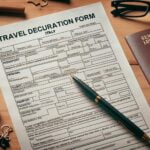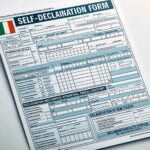The Self-Certification Form for Travel to Italy From Abroad is an essential document that international travelers must complete before entering the country. This form plays a crucial role in ensuring the safety and well-being of both travelers and the local community. By accurately completing this form, travelers provide important information to authorities, enabling them to effectively manage the entry of individuals from abroad.
The self-certification form holds significant importance due to the guidelines and regulations set by the Italian government for international travel. It serves as a means to track and monitor incoming travelers, allowing authorities to assess potential risks and take necessary precautions. Additionally, completing this form accurately not only facilitates a smooth entry process but also contributes to responsible travel by adhering to regulatory requirements.
To obtain and fill out the Self-Certification Form, it is essential to follow a step-by-step guide that breaks down each section of the form. These instructions help travelers understand what information needs to be filled in and ensure that all fields are completed accurately. Paying attention to detail when filling out the form is crucial as any error or omission may lead to unnecessary delays or complications at immigration or customs checkpoints.
Understanding the required information for the Self-Certification Form is vital for a seamless travel experience. This includes providing essential details such as personal identification information, recent travel history, contact details during their stay in Italy, and any other relevant information specified by the authorities. It’s important for travelers to have a clear understanding of each section’s purpose and expectations in order to provide accurate information and avoid potential errors on the form.
Why is the Self-Certification Form required for traveling to Italy from abroad?
The Self-Certification Form is a crucial requirement for travelers entering Italy from abroad due to the Italian government’s guidelines and regulations in place for international travelers. This section will explore the reasons behind the necessity of the form and explain the valuable information it provides to authorities.
When traveling to Italy from abroad, it is important to note that there are specific restrictions and protocols in place to ensure public health and safety. The Italian government has implemented these measures to effectively manage the entry of travelers into the country during the ongoing COVID-19 pandemic. By requiring a self-certification form, the authorities can accurately assess and monitor each traveler’s risk profile, allowing them to take appropriate actions if necessary.
The self-certification form serves as a declaration from travelers themselves regarding their health status, recent travel history, and potential exposure to COVID-19. This information is critical in identifying and tracing potential cases or outbreaks, as well as assessing the risk of imported infections.
The form also provides useful data for contact tracing efforts, should it be required in the event of an outbreak. Therefore, completing this form accurately and honestly is not only a legal requirement but also a responsible act that contributes to safeguarding public health in Italy.
To obtain and fill out the self-certification form correctly, travelers should follow a step-by-step guide that ensures accuracy and completeness. The first step is downloading the form from official sources such as government websites or embassy portals. It is essential to use reliable sources to ensure you have access to the most up-to-date version of the form with any recent changes or updates incorporated.
Once downloaded, carefully read through each section of the form before filling it out. There are several sections where specific information must be provided, including personal details (such as name, address, date of birth), travel details (such as arrival date and flight number), contact information (including phone numbers), recent travel history within designated timeframes (typically 14 days), and details regarding any COVID-19 symptoms or contacts with infected individuals.
It is crucial to provide accurate and truthful information in each section.
To ensure accuracy, double-check all the information you have provided before signing and submitting the form. Mistakes or inaccuracies could lead to delays or complications during your travel to Italy.
Take the time to review each section, ensuring that all fields are completed correctly, and there are no typographical errors or missing information. By completing the self-certification form thoroughly and accurately, you can help facilitate your entry into Italy and contribute to the successful implementation of public health measures.
Step-by-step guide on how to obtain and fill the Self-Certification Form
Downloading the Self-Certification Form
To obtain the Self-Certification Form for travel to Italy from abroad, follow these step-by-step instructions:
- Visit the official website of the Italian Ministry of Health or the Ministry of Foreign Affairs. These websites usually provide a downloadable version of the form.
- Look for a dedicated section or page related to COVID-19 travel guidelines or forms for international travelers. It may be listed under “Travel Restrictions” or “Visa and Entry Requirements.”
- Once you locate the appropriate webpage, navigate to the section that provides information about the self-certification form specifically.
- Download the Self-Certification Form by clicking on the provided link/button. The form is typically available in PDF format.
- Save a copy of the downloaded form on your device or print it out for convenience.
Filling in the Form
Now that you have obtained a copy of the Self-Certification Form, follow these tips to ensure accurate and complete filling:
- Begin by carefully reading all instructions provided on the form itself and any accompanying guidelines mentioned on official websites.
- Section 1 typically requires personal information, such as full name, date of birth, passport details, and contact information. Fill in this section accurately as per your official documents.
- Section 2 focuses on your travel details, including departure and arrival dates, flight number(s), airport(s), and country(ies) visited before entering Italy. Provide precise information based on your itinerary.
- Section 3 deals with health-related questions regarding COVID-19 symptoms or possible exposure before traveling to Italy. Answer honestly and accurately to ensure authorities receive crucial information.
- In Section 4, travelers are often required to declare their commitment to following quarantine measures and abiding by national health regulations during their stay in Italy.
- Sign and date where indicated on the form to certify that the information provided is true and accurate.
Tips for Accuracy and Completeness
To ensure accuracy and completeness of the Self-Certification Form, consider the following tips:
- Double-check all details before submitting the form. Mistakes or inaccuracies may lead to delays, complications, or even denial of entry.
- Use official documents (such as passports or travel itineraries) as references while filling in personal information or travel details.
- If you have any questions or doubts while completing the form, refer to official sources such as government websites or contact relevant consulates or embassies for clarification.
- Keep a copy of the filled-in Self-Certification Form with you throughout your journey for easy reference if needed by authorities at immigration or customs checkpoints in Italy.
Understanding the required information for the Self-Certification Form
The Self-Certification Form for Travel to Italy From Abroad is an essential document that all international travelers visiting Italy must complete. It provides authorities with important information regarding the travelers’ health status, recent travel history, and contact details. This section aims to provide an in-depth understanding of the required information for the form, ensuring that travelers are well-prepared and informed when completing it.
When filling out the Self-Certification Form, travelers will be required to provide various details to comply with the Italian government’s guidelines and regulations. The form consists of several sections, each serving a specific purpose in assessing the traveler’s risk level and facilitating contact tracing if necessary.
One of the crucial parts of the form is providing personal information such as full name, date of birth, passport or ID number, and contact details. These details help authorities track and identify individuals if needed. Additionally, travelers will be asked to declare their recent travel history by providing information about the countries visited in the last 14 days.
Furthermore, it’s important to accurately fill out the section related to health conditions. This includes disclosing any symptoms of COVID-19 within the past 14 days or whether one has been in close contact with confirmed cases. Providing truthful and accurate information helps protect public health by enabling proper monitoring and necessary measures if there is a potential risk.
To further assist travelers in understanding the required information for the Self-Certification Form, let’s take a closer look at some common questions or concerns related to specific sections:
- Can I leave any sections blank?
- Do I need to provide proof of my recent travel history?
- What if I have a pre-existing medical condition?
It is essential to complete all sections of the form truthfully and accurately. Leaving any sections blank may result in delays at immigration or border control checkpoints.
While you don’t necessarily need to provide supporting documents for your recent travel history when completing the self-certification form, it is advisable to carry relevant documentation like flight tickets or hotel reservations in case authorities require further verification.
If you have a pre-existing medical condition, it is important to truthfully declare it on the form. This information helps authorities understand any potential increased risk and take appropriate measures to ensure your safety and the safety of others.
By understanding the required information for the Self-Certification Form, travelers can prepare themselves adequately and ensure they provide accurate details when completing the form. Adhering to these guidelines not only facilitates a smoother travel experience but also contributes to overall public health and safety measures in place.
Frequently asked questions and common mistakes with the Self-Certification Form
One of the key aspects of a seamless travel experience to Italy from abroad is ensuring the proper completion of the Self-Certification Form. While many travelers may have questions or concerns about this form, this section aims to address frequently asked questions and highlight common mistakes that should be avoided when filling out the form.
Common Questions and Concerns
1. Do I need to complete a separate Self-Certification Form for each person in my traveling party?
Yes, each traveler is required to complete their own individual Self-Certification Form. This includes adults as well as minors.
2. What happens if I make a mistake on the form?
It is important to ensure accuracy when filling out the Self-Certification Form, as any mistakes or omissions could lead to delays or complications during your travel. If you realize an error after submitting the form, it is recommended to contact the appropriate authorities at your departure airport or port for guidance on rectifying the mistake.
3. Can I complete and submit the Self-Certification Form electronically?
Yes, travelers have the option to complete and submit the Self-Certification Form electronically through designated online platforms. However, it is advisable to check with your specific airline or transport provider regarding their preferred method for submitting the form.
Common Mistakes to Avoid
1. Incomplete information: One of the most common mistakes made when completing the Self-Certification Form is failing to provide all necessary information in each section. Ensure that all fields are filled out accurately and completely before submitting.
2. Incorrect dates and times: When providing details such as arrival date, departure date, and flight numbers, it is vital to double-check these details for accuracy. Make sure that there are no errors in dates or times that may cause confusion or discrepancies.
3. Failure to sign the form: The Self-Certification Form must be signed by the traveler, confirming that all information provided is accurate and truthful. Neglecting to sign the form may result in it being deemed invalid, potentially causing issues during travel.
As travelers navigate the process of completing the Self-Certification Form, it is important to keep these frequently asked questions and common mistakes in mind. By understanding and avoiding these pitfalls, travelers can ensure a smoother journey to Italy from abroad without unnecessary complications.
| Common Questions | Common Mistakes |
|---|---|
| Do I need to complete a separate Self-Certification Form for each person in my traveling party? | Incomplete information |
| What happens if I make a mistake on the form? | Incorrect dates and times |
| Can I complete and submit the Self-Certification Form electronically? | Failure to sign the form |
Tips for a hassle-free travel experience with the Self-Certification Form
Prepare and Organize Necessary Documents
Before you begin your journey to Italy, it is essential to ensure that you have all the necessary documents readily accessible. This includes your passport, visa (if applicable), proof of accommodation in Italy, and any other supporting documents required for your specific travel situation. It is prudent to keep these documents organized in a secure folder or envelope so that they are easily accessible when needed.
Additionally, it is crucial to have a printed copy of the Self-Certification Form for Travel to Italy From Abroad. Although some airports may provide forms at immigration or customs checkpoints, having the form filled out in advance can save you time and hassle during the check-in process, especially if there is a high volume of travelers.
Follow Recommended Practices at Immigration or Customs Checkpoints
Upon arrival in Italy, you will need to navigate through immigration and customs checkpoints. To ensure a smooth process, there are several recommended practices to follow:
- Have your documents ready: Present your passport and any required supporting documents promptly when requested by authorities.
- Show compliance with regulations: Be prepared to demonstrate that you have completed the Self-Certification Form accurately by presenting it along with any additional documentation provided on the form (e.g., negative COVID-19 test results).
- Cooperate with authorities: Stay calm and respectful while interacting with immigration or customs officers. Answer their questions truthfully and concisely.
It is important to note that failure to comply with immigration regulations or providing inaccurate information on the Self-Certification Form can result in delays, fines, or even denial of entry into Italy. Therefore, it is crucial to understand the requirements before traveling.
Stay Informed About Regulatory Updates
Travel regulations are subject to change due to evolving circumstances related to the ongoing pandemic or other factors. To stay updated on any changes regarding the Self-Certification Form or other travel requirements for Italy, it is recommended to regularly check official government websites or reliable sources of information.
The Ministry of Foreign Affairs and the Ministry of Health in Italy provide official guidelines and updates for international travelers. These resources can provide valuable insights into any new regulations, exemptions, or exceptions that may affect your travel plans. By staying informed, you can ensure that you have the most up-to-date information and be better prepared for your journey to Italy.
Remember, responsible travel entails adhering to regulatory requirements and prioritizing the safety and well-being of yourself and others. By following these tips for a hassle-free experience with the Self-Certification Form, you can contribute to a smooth travel process and make your trip to Italy more enjoyable.
Special considerations and exceptions for specific groups of travelers
When it comes to traveling to Italy from abroad, certain categories of travelers may have special considerations or additional requirements regarding the self-certification form. It is important for individuals falling under these categories to be aware of any specific guidelines they need to follow when filling out the form.
- Children: Parents or guardians traveling with children are responsible for completing the form on behalf of their minors. The information provided should accurately represent both the child and the accompanying adult. Additionally, it is necessary to include any relevant supporting documents, such as birth certificates or passports, to verify the relationship between the child and the accompanying adult.
- Elderly: Elderly travelers may face unique challenges in completing the self-certification form. It is crucial for them to ensure that all sections of the form are accurately filled out with precise details. If needed, they may seek assistance from family members, friends, or travel agents to complete the form correctly. It is also advisable for elderly travelers to carry along any necessary medical documents or prescriptions that may be required during their stay in Italy.
- Disabled: Travelers with disabilities should provide detailed and accurate information related to their condition in the self-certification form. This includes any documentation regarding their disability status and any required accommodations during their travel and stay in Italy. It is essential for disabled travelers to communicate their needs clearly, ensuring that they can receive appropriate support both during transportation and at their destination.
By understanding these exceptional circumstances faced by specific groups, travelers can meet the expected requirements of completing the self-certification form accurately and thoroughly. Ensuring compliance with these guidelines will help facilitate a smoother travel experience for everyone involved while maintaining safety protocols and regulations set forth by Italian authorities.
Important updates and changes in travel regulations related to the Self-Certification Form
As travelers, it is crucial to stay informed about any recent updates or modifications to travel regulations when planning a trip abroad. The same applies to travel regulations related to the Self-Certification Form for Travel to Italy From Abroad. To ensure a smooth and hassle-free journey, it is essential to be aware of any changes that may impact your travel plans.
The Italian government regularly updates its guidelines and requirements for international travelers entering Italy. These updates may include changes in quarantine rules, testing requirements, or entry restrictions based on the current COVID-19 situation. Therefore, it is advisable to check for the latest information on official government websites or consult with the appropriate authorities before your departure.
One of the most reliable sources of information regarding travel regulations and updates is the website of the Italian Ministry of Foreign Affairs and International Cooperation. They provide comprehensive and up-to-date resources for travelers, including specific guidance on completing the Self-Certification Form accurately. Checking this website regularly will ensure that you are well-informed about any changes that may affect your travel plans.
In addition to official government sources, it can be beneficial to follow reputable news outlets or subscribe to travel advisories issued by your country’s embassy or consulate in Italy. These sources often provide timely updates on any significant developments that may impact travelers. Staying informed will give you peace of mind and help you make necessary adjustments to your travel plans if needed.
Remember, responsible travel involves not only completing the Self-Certification Form accurately but also staying updated with any important changes in travel regulations. By doing so, you contribute to maintaining public health and safety while enjoying a smooth journey to Italy from abroad.
Conclusion
In conclusion, the Self-Certification Form for Travel to Italy From Abroad plays a vital role in ensuring safe and responsible travel. It is not just a bureaucratic requirement but rather a tool that helps protect individuals and communities from the potential spread of COVID-19. By accurately completing this form, travelers are providing crucial information to the authorities, which allows for effective monitoring and control of the pandemic situation.
It is important to recognize the significance of filling out the Self-Certification Form accurately. Each detail provided on the form contributes to the overall understanding of an individual’s travel history and potential risk factors. By diligently providing truthful information, travelers can help Italian authorities make informed decisions regarding entry requirements, testing protocols, or necessary quarantine measures.
Responsible travel should be prioritized by all travelers heading to Italy from abroad. Adhering to regulatory requirements like completing the Self-Certification Form not only supports public health efforts but also demonstrates respect for local regulations and concerns. By doing so, travelers can contribute to maintaining a safe environment not just for themselves but also for the local community they are visiting.
Using the self-certification form is a straightforward process that brings numerous benefits. It streamlines immigration procedures, acts as proof of compliance with regulations, and minimizes misunderstandings or miscommunications between travelers and officials. Through proper completion of the form, travelers can have a hassle-free experience at immigration or customs checkpoints while contributing to an overall smoother process.
Frequently Asked Questions
Do I need to fill out self declaration form to travel to Italy?
Yes, if you are traveling to Italy, it is necessary to fill out a self declaration form. The self declaration form is a mandatory requirement for all individuals entering the country.
This form provides essential information about your health status and recent travel history, including any potential exposure to COVID-19. It is part of the Italian government’s efforts to track and control the spread of the virus within its borders.
What paperwork do I need to enter Italy?
When entering Italy, you will need several documents besides the self declaration form. One of the main paperwork requirements is a negative COVID-19 test result obtained within 48 hours before your arrival in Italy.
This test should be either an antigen or molecular (PCR) test. Additionally, travelers may be subject to a temperature screening or further testing upon arrival at an Italian airport or port.
How do I get a self declaration form?
To obtain a self declaration form for travel to Italy, there are various methods available depending on your specific circumstances. Most commonly, these forms can be acquired through airlines or travel agencies prior to departure as they have been instructed by Italian authorities to distribute them electronically or as hard copies during check-in processes.
It is also possible to obtain the form from Italian diplomatic missions abroad or directly from the Italian Ministry of Health’s website where you can download and print it before traveling. Don’t forget that each traveler must fill out their own individual self declaration form with accurate information regarding their personal health and previous movements within a specified timeframe preceding their arrival in Italy.

I’m a passionate traveler, writer, and Italophile. My fascination with Italy’s history, art, and culture has led me on countless adventures across the Italian landscape. Through “I Live Italy,” I share my love for this extraordinary country and aims to inspire others to explore its boundless beauty.





